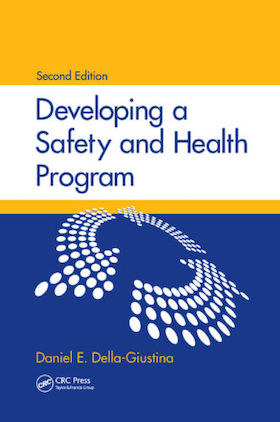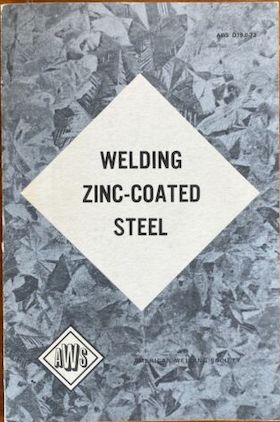
Curated with aloha by
Ted Mooney, P.E. RET

The authoritative public forum
for Metal Finishing 1989-2025

-----
Safety/Danger of Grinding Galvanized Metal
Q. I am working with galvanized metal products. I grind them with a hand held angle grinder ⇦ this on eBay or Amazon [affil links] , which produces a lot of dust. Could anyone tell me the health risk involved in this and what kind of protection I should be using?
Richard Beeching- Lydd-on-Sea, Kent, U.K.
2002
A. Protecting employees from hazards is an employer obligation, so I assume you are self-employed or this is a hobby.
Although zinc is not hazardous in the sense that cadmium, mercury, and lead are, you don't want to breathe any dusts at all, whether work or hobby, wood or metal or plastic. And you probably have no good way of being sure there is no cadmium or lead on the parts you are working with. So you would certainly want a particulate filter as a minimum.
Although welding produces very high temperatures that vaporize zinc, allowing inhalation of the vapor, I don't think grinding will produce zinc fumes, but a suction-type exhaust system or fan may a good idea to be on the safe side. Physicians can do blood monitoring, and if you are working intensively with this stuff you perhaps should be monitored.

Ted Mooney, P.E.
Striving to live Aloha
finishing.com - Pine Beach, New Jersey
2002
A. THE MOST SENSIBLE SUGGESTION TO YOU WOULD BE IS TO MAKE SURE YOU ARE RESPECTING YOUR HEALTH BY WEARING A MASK, PREFERABLY A CHARCOAL FILLED MASK AND TRY NOT TO GRIND TOWARDS YOURSELF IF THERE ARE NO FUMES, THERE SHOULD NOT BE A STRONG CONCERN. WHERE THERE ARE FUMES NORMALLY AN EXHAUST SYSTEM SHOULD BE USED AND TRY TO WORK IN AN OPEN AREA.
GEORGE TOH- CANADA
2003
A. In reference to the respirator advice given above, for protection from particulates (fumes, dusts, etc.) you should have a respirator with a particulate filter (such as a N-95, or HEPA filter). A charcoal filter will only work for vapors, such as solvents. A charcoal filter will provide no protection against fumes or dusts.
As a side note, a particulate filter respirator can cause some degree of stress, as it is more strenuous to breath through them. OSHA requires that employees who wear respiratory protection undergo a medical review to ensure that wearing a respirator will not endanger their health. Though it is not common, some individuals with an underlying physical ailment such as cardiovascular disease or asthma may be adversely affected by wearing respiratory protection.
- Oklahoma City, Oklahoma
2006
Q. What are the symptoms of inhalation of fumes caused by grinding galvanised metal?
geoffrey kendrew- Wales UK
February 1, 2011
A. Hi, Geoffrey.
I don't know whether we have established that grinding produces zinc fumes or not. The fumes come from vaporization of the metal, and vaporization occurs at a much higher temperature than melting. Grinding wouldn't work too well if you were melting the material. But look up "metal fume fever"; the symptoms are supposedly similar to the flu but last only a few days instead of a week or more. If you only got it once, it's probably difficult to tell if zinc was responsible or not; but if it's repetitive and associated, then it's a good bet.
Regards,

Ted Mooney, P.E.
Striving to live Aloha
finishing.com - Pine Beach, New Jersey
February 2, 2011
A. To fully protect yourself, I would highly recommend a 3M Particulate Filter 2091/07000(AAD), P100 Respiratory Protection or at the very least a dust mask. I work with galvanized steel on a consistent basis. I know what it is like to get ill from breathing or being exposed to fumes and inhaling the galvanized dust. It's some bad stuff. If you're questionable about it, put on some PPE. Be safe out there.
Paul NashUnion Ironworker Local #3 - Altoona, Pennsylvania USA
December 18, 2015
![]() Hi Paul. I guess you're saying that grinding can produce dusts that can be inhaled and cause zinc fume fever. Nice to get an answer.
Hi Paul. I guess you're saying that grinding can produce dusts that can be inhaled and cause zinc fume fever. Nice to get an answer.
Regards,

Ted Mooney, P.E. RET
Striving to live Aloha
finishing.com - Pine Beach, New Jersey
December 2015
A. Regarding the opinions expressed above about zinc vaporization:
It is obviously correct that a grinding operation is not intended to "melt the metal". But what that actually means is not melt the BASE metal. The steel base metal gets red hot on occasion locally (right at the grinding or cutting wheel) meaning it is 1600-1800 °F. Zinc melts at about 790 °F and boils to vapor at about 1650 °F. Therefore zinc oxide vapor can absolutely be created by grinding galvanized steel without "melting" the base metal in a welding operation or otherwise.
The likelihood of producing the zinc vapor in significant quantities goes up with reduced thickness of the workpiece. So sheet metal with two galvanized surfaces and low mass of steel will get hot and produce lots of vapor, while a thick walled galvanized pipe will not produce as much due to the higher "thermal mass" of steel and not vaporizing inside and outside surface simultaneously.
Bottom line, if the steel gets "red" or into the "orange" spectrum, then zinc vapor is produced.
- south lake tahoe, California, usa
April 9, 2017
Q. My neighbor cuts galvanized pipes in his garage. He has an awning business. He vents into my backyard. Is this dangerous to my health? My husband passed away with lung cancer 2 years ago.
Jane McNally- Commack, New York, USA
September 4, 2019
A. Hi Jane. Sorry about the loss of your husband. Zinc is an important micronutrient, not a toxin/poison. Your neighbor and his employees, when doing repetitive close-up work, might possibly expose themselves to enough zinc vapor to induce zinc fume fever, but I doubt that they do -- this is usually only a problem for welders who generate and inhale clouds of zinc vapor.
Personally, I doubt that any zinc vapor would even be detectable even right next to his fans. And again, it's not poison, it's a matter that a huge overdose of an essential nutrient can make people sick. But I suppose you could call a NY state EPA or OSHA hotline. I'm not sure what you mean by venting into your back yard though; if his garage runs clear to the property line and includes a vent through the wall that actually directly dumps onto your property, that doesn't sound neighborly :-)
Regards,

Ted Mooney, P.E. RET
Striving to live Aloha
finishing.com - Pine Beach, New Jersey
September 2019
Safety of Sanding Galvanized Metal
Q. Are there any related health risks to sanding galvanized metal for paint prep? Taking all necessary PPE precautions, does sanding the galv finish, making it airborne, cause any health concerns for the worker directly involved in the process and the population working around them?
James RandallConcealFab - Colorado Springs Colorado USA
September 19, 2019
A. Hi James. As you apparently already realize, inhaling anything besides air is bad for you, so dust masks of whatever type you choose for other sanding operations should be used. Zinc is not a toxin or a poison -- in fact it's an important micro-nutrient. The problem comes when welders inhale big clouds of vaporized zinc and consume a huge overdose.
Regards,

Ted Mooney, P.E. RET
Striving to live Aloha
finishing.com - Pine Beach, New Jersey
A. Zinc is not to be overly concerned about; after all, it is an essential micronutrient and among other things, it helps to prevent colds. But one element is definitely worthy of your concern, and that is lead. Lead is a poison that accumulates in bodies. Years ago, substantially all hot-dip galvanizing was done with Prime Western Zinc, a zinc-lead alloy that contains up to 1.4% lead (deliberately added - not an impurity). The lead helps in the hot-dip process. ASTM B6-23 covers this alloy. Today, many hot-dip galvanizers have gone away from lead alloys, but certainly not all. Inexpensive surface tests for lead are readily available online or from most hardware stores.

Tom Rochester
CTO - Jackson, Michigan, USA
Plating Systems & Technologies, Inc.

September 28, 2019
![]() Thank you for your quick response to my question regarding any health/safety risks involved with sanding galvanized metal. Your information was very helpful and guiding our organization in a correct path.
Thank you for your quick response to my question regarding any health/safety risks involved with sanding galvanized metal. Your information was very helpful and guiding our organization in a correct path.
ConcealFab - Colorado Springs Colorado USA
October 2, 2019
Q, A, or Comment on THIS thread -or- Start a NEW Thread

